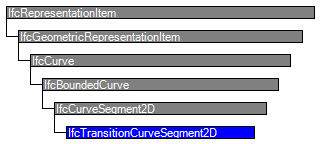Natural language names
 | Transition Curve Segment 2D |
Change log
| Item | SPF | XML | Change | Description | IFC4x1 Release Candidate 3 |
|---|---|---|---|---|
| IfcTransitionCurveSegment2D | ADDED | IFC4x1 Final | ||
| IfcTransitionCurveSegment2D | ||||
| StartRadius | MODIFIED | Type changed from IfcLengthMeasure to IfcPositiveLengthMeasure. | ||
| EndRadius | MODIFIED | Type changed from IfcLengthMeasure to IfcPositiveLengthMeasure. |
Semantic definitions at the entity
Entity definition
An IfcTransitionCurveSegment2D is a curve that transitions between a straight line and a circular arc (or the reverse).
Attribute definitions
| # | Attribute | Type | Cardinality | Description | G |
|---|---|---|---|---|---|
| 4 | StartRadius | IfcPositiveLengthMeasure | ? | The radius of the curve at the start point. If the radius is not provided by a value, i.e. being “NIL” it is interpreted as INFINITE – the StartPoint is at the point, where it does not have a curvature. | X |
| 5 | EndRadius | IfcPositiveLengthMeasure | ? | The radius of the curve at the end point. If the radius is not provided by a value, i.e. being “NIL” it is interpreted as INFINITE – the end point is at the point, where it does not have a curvature. | X |
| 6 | IsStartRadiusCCW | IfcBoolean | Indication of the curve starting counter-clockwise or clockwise. The orientation of the curve is IsCcw=”true”, if the spiral arc goes counter-clockwise as seen from the start point and start direction, or “to the left", and with IsCcw=”false” if the spiral arc goes clockwise, or “to the right”. | X | |
| 7 | IsEndRadiusCCW | IfcBoolean | Indication of the curve ending counter-clockwise or clockwise. The orientation of the clothoidal arc is IsCcw=”true”, if the spiral arc goes counter-clockwise as seen towards the end point and end direction, or “to the left", and with IsCcw=”false” if the spiral arc goes clockwise, or “to the right”. | X | |
| 8 | TransitionCurveType | IfcTransitionCurveType | Indicates the specific type of transition curve. | X |
Inherited definitions from supertypes
Entity inheritance

Attribute inheritance
| # | Attribute | Type | Cardinality | Description | G |
|---|---|---|---|---|---|
| IfcRepresentationItem | |||||
| LayerAssignment | IfcPresentationLayerAssignment @AssignedItems | S[0:1] | Assignment of the representation item to a single or multiple layer(s). The LayerAssignments can override a LayerAssignments of the IfcRepresentation it is used within the list of Items.
IFC2x3 CHANGE The inverse attribute LayerAssignments has been added. IFC4 CHANGE The inverse attribute LayerAssignment has been restricted to max 1. Upward compatibility for file based exchange is guaranteed. | X | |
| StyledByItem | IfcStyledItem @Item | S[0:1] | Reference to the IfcStyledItem that provides presentation information to the representation, e.g. a curve style, including colour and thickness to a geometric curve.
IFC2x3 CHANGE The inverse attribute StyledByItem has been added. | X | |
| IfcGeometricRepresentationItem | |||||
| IfcCurve | |||||
| Dim :=IfcCurveDim(SELF) | IfcDimensionCount | The space dimensionality of this abstract class, defined differently for all subtypes, i.e. for IfcLine, IfcConic and IfcBoundedCurve. | X | ||
| IfcBoundedCurve | |||||
| IfcCurveSegment2D | |||||
| 1 | StartPoint | IfcCartesianPoint | The start point of the 2D curve as x/y coordinates defined by a 2D Cartesian point. | X | |
| 2 | StartDirection | IfcPlaneAngleMeasure | The direction of the tangent at the start point. Direction value 0. indicates a curve with a start tangent along the positive x-axis. Values increases counter-clockwise, and decreases clockwise. Depending on the plane angle unit, either degree or radians, the sensible range is -360° ≤ n ≤ 360° (or -2π ≤ n ≤ 2π). Values larger then a full circle (>|360°| or >|2 π| shall not be used. | X | |
| 3 | SegmentLength | IfcPositiveLengthMeasure | The length along the curve | X | |
| IfcTransitionCurveSegment2D | |||||
| 4 | StartRadius | IfcPositiveLengthMeasure | ? | The radius of the curve at the start point. If the radius is not provided by a value, i.e. being “NIL” it is interpreted as INFINITE – the StartPoint is at the point, where it does not have a curvature. | X |
| 5 | EndRadius | IfcPositiveLengthMeasure | ? | The radius of the curve at the end point. If the radius is not provided by a value, i.e. being “NIL” it is interpreted as INFINITE – the end point is at the point, where it does not have a curvature. | X |
| 6 | IsStartRadiusCCW | IfcBoolean | Indication of the curve starting counter-clockwise or clockwise. The orientation of the curve is IsCcw=”true”, if the spiral arc goes counter-clockwise as seen from the start point and start direction, or “to the left", and with IsCcw=”false” if the spiral arc goes clockwise, or “to the right”. | X | |
| 7 | IsEndRadiusCCW | IfcBoolean | Indication of the curve ending counter-clockwise or clockwise. The orientation of the clothoidal arc is IsCcw=”true”, if the spiral arc goes counter-clockwise as seen towards the end point and end direction, or “to the left", and with IsCcw=”false” if the spiral arc goes clockwise, or “to the right”. | X | |
| 8 | TransitionCurveType | IfcTransitionCurveType | Indicates the specific type of transition curve. | X | |
Examples
Formal representations
XML Specification
<xs:element name="IfcTransitionCurveSegment2D" type="ifc:IfcTransitionCurveSegment2D" substitutionGroup="ifc:IfcCurveSegment2D" nillable="true"/>
<xs:complexType name="IfcTransitionCurveSegment2D">
<xs:complexContent>
<xs:extension base="ifc:IfcCurveSegment2D">
<xs:attribute name="StartRadius" type="ifc:IfcPositiveLengthMeasure" use="optional"/>
<xs:attribute name="EndRadius" type="ifc:IfcPositiveLengthMeasure" use="optional"/>
<xs:attribute name="IsStartRadiusCCW" type="ifc:IfcBoolean" use="optional"/>
<xs:attribute name="IsEndRadiusCCW" type="ifc:IfcBoolean" use="optional"/>
<xs:attribute name="TransitionCurveType" type="ifc:IfcTransitionCurveType" use="optional"/>
</xs:extension>
</xs:complexContent>
</xs:complexType>
EXPRESS Specification
ENTITY IfcTransitionCurveSegment2D
SUBTYPE OF (IfcCurveSegment2D);
StartRadius : OPTIONAL IfcPositiveLengthMeasure;
EndRadius : OPTIONAL IfcPositiveLengthMeasure;
IsStartRadiusCCW : IfcBoolean;
IsEndRadiusCCW : IfcBoolean;
TransitionCurveType : IfcTransitionCurveType;
END_ENTITY;

 EXPRESS-G diagram
EXPRESS-G diagram Link to this page
Link to this page